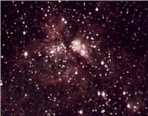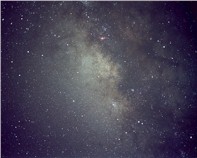 |
|||
Results Click here to see more images taken with the barn door tracker.
Using some maths you can work out the correct placement of the hole for the rod. Before attaching the rod I threaded a nut on the rod and turned it sixty times. I measured the distance of travel. Dividing by sixty gives you an average figure for the distance the rod will move the board per turn of the rod. You want one turn per minute. Using high school trigonometry (took me a while to remember it !!) I was able to work out the correct placement of the rod measured from the hinge. The formula you need is tan ( A ) = y / x so: x = y / tan (A) Where x is the distance you need to drill the hole for the rod. X is measured from the hinge. A is 15 degrees (the sidereal movement for sixty turns (60 minutes x 0.25 )) y is the distance that the rod
traverses with sixty turns (one turn per minute) The rod moves at a right angle to the lower board. The lower board is tilted at an angle equal to your latitude. The hinged edge points at the South Celestial Pole. I used a small bolt to set the lower board to the required angle. I used a bolt so that I can change the setting if I ever go travelling with the barn door. Because the long rod is not curved and is straight and sits at a right angle to the lower board, when you turn the rod at exactly one turn per minute for many minutes, the actual sky will turn at a slightly different rate to the movement of the upper board. This is because the rod is straight and does not follow a circular path. Not a problem. This is why I invented the method to track using the TV camera and manually guide the exposures. Heh, if the big scopes use that method why not apply it to a Barn Door. You can see the results in the images I was able to get. The barn door has a couple of problems. Bumping the whole thing and moving it out of polar alignment is just going to happen, rely on doing it at least once per night. Having to turn the handle by hand means you have to take extreme care. You must caress the handle with the tip of one finger to S-L-O-W-L-Y turn the handle at the required rate. You have to do this for the whole exposure. No goofing off. Concentrate. You'll be delighted to know that for wide-field (28-50 mm) photography by using the TV-guided method there is little difference between the accuracy of a barn door tracker and a cheap motor-driven German Equatorial Mount (GEM). I know because I've taken photos using the motorised mount of a cheap Tasco GEM. I guided it using the same TV method. The results were the same ! (Mind you the gears on the Tasco GEM were badly worn and stripped in places - and the Periodic Error was fun to watch). So if you have a CCD camera that is sensitive enough to put a star on a TV and if you absolutely do not want to spend much money then you may want to give the TV-guided Barn Door a try.
Click here to see more images taken with the barn door tracker.
All images and content of this website are copyright (c)2005 Bill Christie. All rights reserved. |


